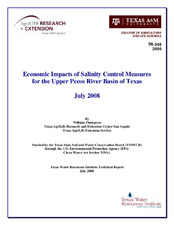| dc.description.abstract | This report presents the results for Subtask 1.7 of the Pecos River Basin Assessment
project sponsored by the U.S. Environmental Protection Agency (EPA) and the Texas
State Soil and Water Conservation Board (TSSWCB). The original objective of Subtask
1.7 was to measure the economic impact of Tamarix spp. (saltcedar) control along the
Texas portion of the Pecos River. As work progressed on other hydrologic studies
associated with this project, the scope of the project shifted to analyze the expected
economic impacts of implementing potential salinity control measures on the Pecos River
above Red Bluff Reservoir to decrease salinity levels in water used for irrigation in
Texas. Scenarios evaluated quantified the economic impact of improving water quality
used by Texas irrigators to the level of water utilized by the Carlsbad Irrigation District in
southern New Mexico. The purpose for this evaluation was to see if the overall economic
impact of producing less salt tolerant, more profitable crops might be significant enough
to encourage producers to convert current cropping practices to more profitable practices
not currently useable due to elevated irrigation water salinity levels.
Between 1970-2005, irrigation storage and delivery data from the Red Bluff Water Power
Control District (RBWPCD) were analyzed and water delivery from the year 2005 was
used as a representative level of available irrigation water. Estimates of current cropping
patterns for the irrigated lands within the seven sub-districts of the RBWPCD were
established. Data were collected and reviewed for the Carlsbad Irrigation District of New
Mexico, just up stream from Red Bluff Reservoir, to establish two estimated alternative
cropping patterns under a reduced salinity environment. The differences in the value of
farm production between the baseline scenario and the two alternative cropping patterns
were entered into the Impact Analysis for Planning (IMPLAN) input-output model of the
six county upper Pecos River Basin to quantify the general economic impact to the local
economy as a result of changes in current cropping practices.
As compared to the typical cropping practices, Alternative 1 reduces the more salt
tolerant cotton acreage and moderately tolerant wheat acreage while increasing the
acreage of moderately salt sensitive alfalfa. The direct output effect for this alternative
cropping pattern was $1,446,206; an increase of 120 percent over the current typical
cropping system. The total economic impact to the local economy was $2,807,166 with a
net creation of 1.17 full time employee (FTE) jobs. This scenario did not incorporate the
impacts to local cotton gins and as a result may be a less desirable option.
Alternative 2 maintains cotton acreage, reduces wheat acres, and increases alfalfa acres as
compared to typical practices. Compared to Alternative 1, this scenario models one-third
of the alfalfa acreage, 5.5 times more acres cotton and equal amounts of wheat. The direct
output effect for this alternative cropping pattern was $815,378; an increase of 130
percent over the current typical cropping system. The total economic impact was
$1,588,795, and will generate a net increase of 7.8 FTE jobs.
2
The combined effective delivery losses of the Pecos River channel and the sub-district
delivery infrastructure have averaged 55.5 percent since 1970. Uncertainty stemming
from weather patterns, annual irrigation water availability, and the delivery losses of the
current system complicate planning and deter investments by both farmers and irrigation
districts making a large-scale conversion from current cropping practices to potentially
more profitable practices less likely. In order to increase the likelihood of cropping
changes and promote future irrigated agriculture in the basin, a new study of the
infrastructure improvements for the RBWPCD and the 7 sub-districts is needed; this was
last done in 1991.
This study did not measure the impact of increasing available water supplies because it is
outside the revised scope of the project and is furthermore an unlikely scenario given the
region’s climate. Tremendous increases in grain prices, fuel, and fertilizer costs in recent
months can potentially alter economic impacts predicted by this study; these dramatic
changes have likely changed demand and production functions of several industries. An
updated analysis is needed to better quantify potential economic impacts under the
current economic situation.
The primary focus of this analysis has been on irrigated farm production; however, the
initial intent was to evaluate the economic impacts of saltcedar control in the riparian
corridor in general. A large majority of lands in the riparian corridor and watershed are
classified as rangelands; which can have a significant impact on the watershed’s
economy. Results of a survey of landowners/managers along the Pecos River can be
found in appendix 2. This survey was conducted to quantify economic impacts realized
by landowners along the river as a result of saltcedar treatment along the river. Generally
speaking, these landowners/operators have had little economic benefit or value from the
treatment of saltcedar along the Pecos River. | en |


